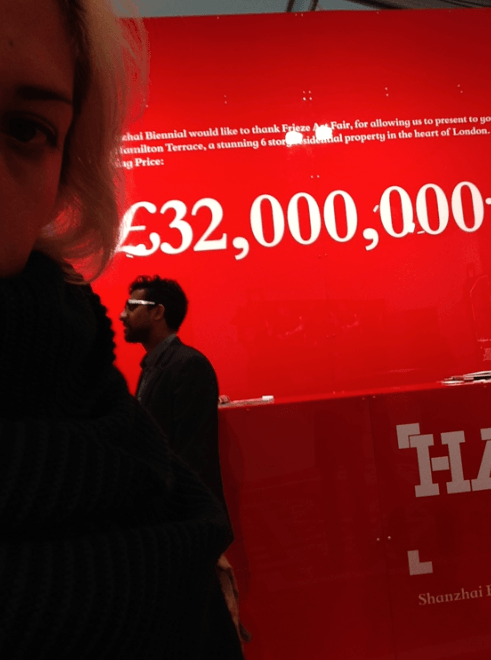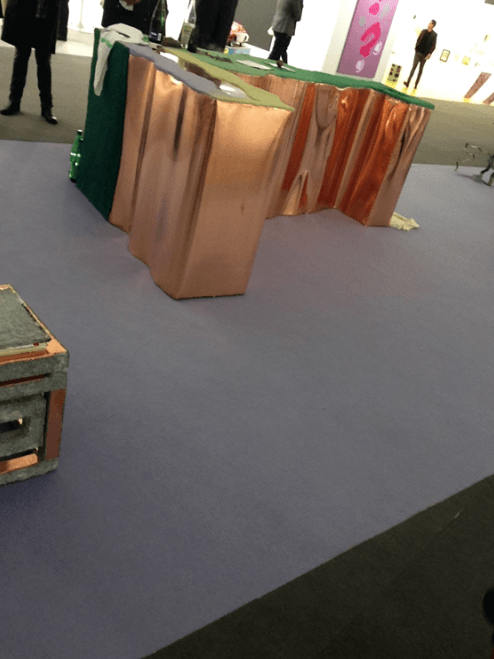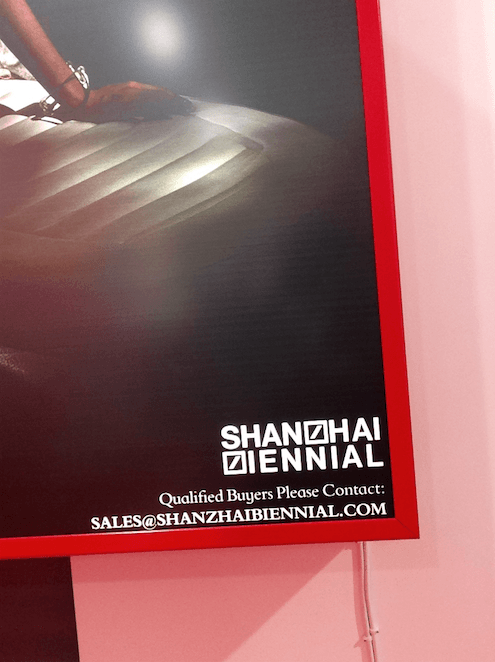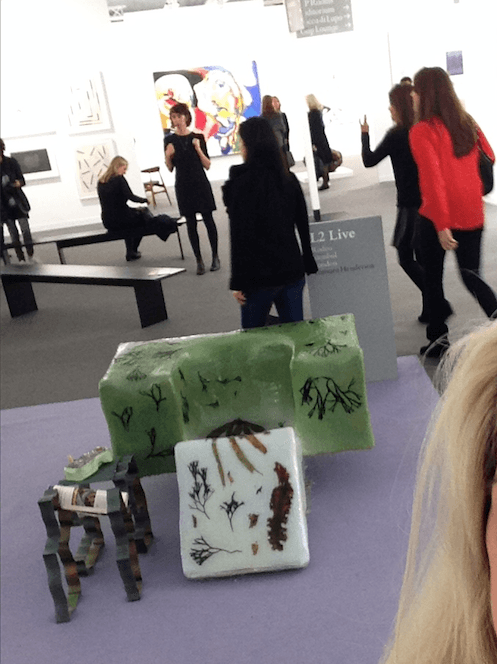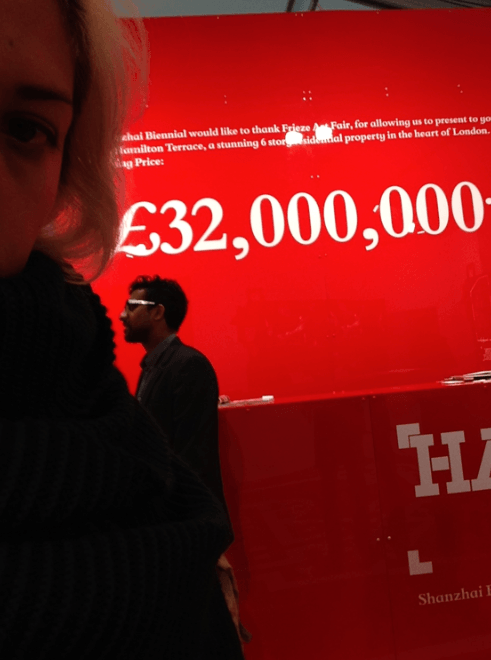Frieze London Preview Days, lazyy styyle
Oct. 23, 2014
Day five Kirkenes, day one London. Fresh off the Arctic where I was on a journey to explore the effects of pollution on the border region between Norway and Russia, I arrive in London and step into another type of desolation: Frieze Art Fair preview days. And while the air in this temporary art-tent city in Regents Park doesn’t smell of sulfur, it stinks of new and clean filth—carpet glue and fresh paint, fusing with duty-free perfumes, and I swear, I can almost feel the amygdala centers of the surrounding brains, including my own, pulsating, firing hormones into our bodies as potential social and financial rewards are in sight.
Truth be told, the only thing I actually saw at Frieze is Live, a new section of the fair devoted to performance-based installations. And this is the first thing anyone who attended Frieze saw, as it was occupying prime real estate—the entrance space just outside the ticket line, meaning that even without a ticket you could see the project by Shanzhai Biennial. Presented by the young London-based gallery Project Native Informant, Shanzhai Biennial is a New York-based artist collective comprised of Avena Gallagher, Babak Radboy and Cyril Duval who conceive of themselves as “a multinational brand posing as an art project posing as a multinational brand posing as a biennial.” They have created an installation, a space that, to the unknowing eye, could look like a typical big-name gallery booth—everything looks and feels expensive, glossy, hyper-corporate, and red. Potentials for value creation are everywhere, from the huddled Artforum writer hiding behind the counter racing to meet a deadline—a quick “hey” and back to work—to the 32 million pound London house (Hamilton Terrace, St John’s Wood, London, NW8), which Shanzhai Biennial is actually selling through their installation, and for which they will of course be taking a healthy commission. The artists and the gallerist are present, and in their best creative-entrepreneur stances, ready to answer your questions, well, sort-of, because as the advertisements on the wall state: “qualified buyers only.” They, including the project, work hard at navigating all of the corporo-semio-socio-economo codes, from the images on the walls, to the large graphics printed on the carpet, to the font choice (permissibly lent to them by Frieze) and also in their own bodies. Does the sweat on his brow count as a positive in semiotic terms? What about in art fair terms? In business terms it’s surely a no-no, “don’t ever let them see you sweat”…in art cultural coding, it could be sort of romantic and endearing, no? Well, I can see why I’m not a qualified buyer. Selling a lifestyle is the art of exchanging cultural value for actual economic gain. Shanzhai Biennial is an attempt, perhaps, at not playing out the contemporary labor paradigm of constantly working for little or no pay., but still ….. Curious to see if it will cash out.
Also part of Live is the presentation of Istanbul gallery Rodeo showing new work by Stockholm-based artist Tamara Henderson. Her installation titled Resorting is inspired by the idea of vacationing and includes some of the sculptural furniture for which Henderson is known, integrated for the first time with performative elements. The resin-based chairs and a bar, from which a soothing smoke emanates from time to time, are meant to be interacted with and provoke feelings of relaxation. There is a bartender who appears at the bar and does reflexology on the participants. I take a seat on one of the chairs, put my feet up on the ottoman and see that the resin is filled with little twigs and leaves. I lift up the chunky phone-sculpture next to my armrest—I’ve been here before on a Silva mind control session back in Oslo, eyes closed, listening for an answer from my subconscious via my mind-phone—I listen to an excerpt from Henderson’s past-life regression hypnosis. In this particular area of Frieze, wide open to the noisy and chaotic elements of the fair, it’s incredibly hard to find a relaxing mental space. That’s not what I came here for. No delusions about art fairs needing to provide optimal viewing conditions for art, since we all know that these settings are made to streamline the conditions for art’s economic transactions, however, it makes me wonder why so many artists who are exploring the spiritual/subconscious experientially would show this type of work at an art fair. Or rather, why her gallery would show it at this speedy art-marketplace, which simply turns these gestures into pure novelty.
This year, I must say, I took it pretty easy. I didn’t see that much more. I bounced here and there, a Constant Dullaart rave-lecture at the ICA off-site, a day nerding-out on philosophy lectures, first at Tate and then at Goldsmiths, a Timur Si-Qin solo show about death and funerals, a Pierre Huyghe about death, funerals, and a monkey, a dance party with Katja, Dora, Mike, Anna, Sandra, Christopher, Annika, there was an Oscar and Harry in there somewhere too. I spent a lot of time in a living room in Peckham, upstairs from a soon-to-be-launched art gallery. Perhaps with experience one gets lazier, as they say. Pretty sure no one says that. But I’m gonna interpret my own wisdom this way: it’s important to cultivate laziness especially in the midst of chaos and social olympics. Able to fend off the FOMO, I instead enjoyed my hour-ish long daily bus rides to wherever I felt like going. And on the third Frieze preview day, I peeled myself up off the floor, came to terms once again with being culturally valued but economically poor, and submitted my ‘Statens’ application like a good girl. Everyone always hates themselves, sometimes. Till next time folks!
Agatha Wara is a Bolivian-born, U.S. raised curator and writer. Wara has recently written on the work of Yngve Holen, Katja Novitskova, Timur Si-Qin, and Anne de Vries. She is currently based in Oslo.
